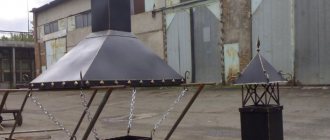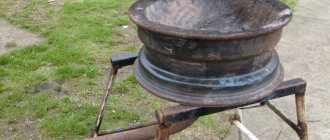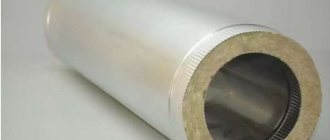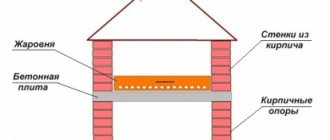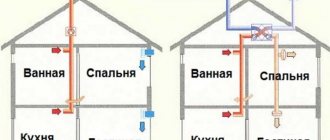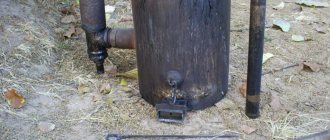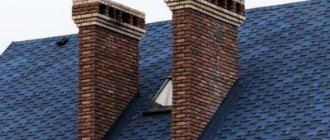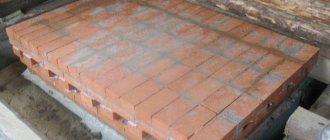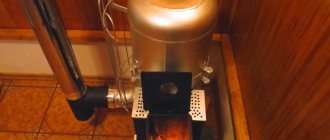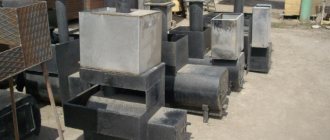Manufacturing process
Now you need to secure the product to the pipe using two methods:
- Constructing a wire frame on a metal pipe.
- Implanting ordinary nails into the brickwork of a chimney pipe.
If you wish, you can decorate homemade pipe caps; here the master’s imagination has no limits. The simplest way is to beautifully design the edges of the chimney: using the wavy trimming method or using cuts and folding of the petals.
Thus, by taking the time to make an umbrella, you can extend the service life of the chimney pipe and give the roof a finished look.
Cooking meat, fish and vegetables on the grill is a traditional, pleasant, festive affair, but it has its drawbacks. The process is sometimes interrupted by bad weather, and the smoke wafting through the yard creates some discomfort for those around. To make grilling barbecue a pleasure, use a barbecue umbrella. The element is installed above the firebox and serves as a smoke exhaust.
Features of brick construction
The basis of the dome is an iron frame welded from a strong corner. Before laying, it is treated with a primer and painted for better protection. Since the temperature directly above the firebox is quite high, the smoke collector is made of refractory bricks. The shape of the structure is stepped, tapering.
The chimney is made of both fireclay and stove bricks. If the barbecue is located in an open area, drainage slopes are made of heat-resistant roofing material on the walls of the smoke collector. Then, during precipitation, moisture will not destroy the building structure. The umbrella over the chimney is metal.
Features of the device and its purpose
An important part of the heating system is the chimney, regardless of where the smoke is discharged, be it a stove or a gas boiler. Most often, the chimney is a pipe that has access to the roof
An unclosed chimney very quickly ceases to perform its functions, so it needs protection such as an umbrella for the chimney pipe.
In addition to its protective function, the umbrella has the following purposes:
- Fixes and strengthens brick or stone masonry.
- Prevents destruction of the top part of the pipe.
- Removes condensation and excess moisture.
- Completes the appearance of the pipe and the entire roof.
The main part of the structure is the head, made in a free form and having downward edges (read: " "). Additional structural elements include: a drip tray, a device designed to collect condensate, and fixing elements. The drip cap is not a mandatory element, but its absence leads to a reduction in service life, since the masonry is destroyed under the influence of moisture, and corrosion may appear on the metal parts. For the same reason, it is recommended to install additional protection in the form of a mesh.
Useful functions and operating principle
Making the exhaust part with your own hands is a feasible task. The smoke collector for the barbecue performs two main functions:
- Removal of volatile compounds. In essence, an umbrella is a chimney that raises the gases generated during combustion. Like the barbecue oven system, the action is based on draft force. With sufficient combustion intensity, the smoke heats up to such a temperature that it becomes lighter than the surrounding air and tends upward. If an umbrella is installed, combustion products do not have time to dissipate, but are collected in a pipe and released only at the end of the chimney. Thus, all unpleasant compounds disappear without causing harm to humans.
- Protection of the frying surface from precipitation. This is ensured by the presence of a smoke collector, which, due to expansion, covers the entire grill. Typically, this function is performed by a gazebo or canopy, under which a frying device is installed, but an umbrella allows you to use the grill both under the roof and in an open area.
Umbrella design
Exhaust ventilation is a simple device. Precision is important in manufacturing, so it is recommended to use a drawing. The umbrella consists of 3 parts, each of which serves for gradual smoke removal:
- Smoke collector, or chimney. The task of this element is to collect all volatile compounds from the frying plane into one pass of a narrower cross-section. For rectangular and square barbecues, the classic shape of the smoke collector is a truncated pyramid: 4 sides tapering towards the top. For devices with a round firebox, the collection is a cone.
- An umbrella is a small but important element. It is installed above the pipe at a height of 10-20 cm and protects the chimney from precipitation without interfering with the removal of combustion products.
A pipe, or, actually, a chimney. The function of this element is to raise the collected smoke to a specified height. As a rule, 3 meters above ground level is sufficient: this is higher than a person’s height and does not allow combustion products to fall in the wind. The shape of the pipe depends on the collector: rectangular cross-section for a pyramidal nozzle, round for a cone. The main thing is to hermetically connect the internal volume.
Metal umbrella
To make the hood, durable stainless steel or sheet metal with a protective coating 2-3 mm thick is used. The whole sheet is lined. Separately cut out parts for the collector, pipe and elements for the umbrella. After bending the cut parts into shape, the seams are welded or fastened with rivets or latches.
Thematic material:
Installing an umbrella over a barbecue can be done in different ways:
The root of construction troubles is hidden in the little things. By neglecting small details, the owner of a private home ineffectively inflates the family budget with repair costs. But if the owner treats the house as an integral organism in which everything is interconnected, his money does not go down the drain, and costs are limited to routine maintenance. Improper installation of protective devices on the chimney provokes losses - both financial and human.
Installing an umbrella on the chimney helps maintain the operation of the heating system in optimal mode, prevent premature aging of the chimney, and improve air circulation in the house.
Caps and heads on pipes are designed for the following purposes:
- cover the ventilation duct, protecting it from rain, snow and dirt. Lack of protection can lead to the accumulation of a large amount of water in the chimney, which contributes to a decrease in draft and, accordingly, a drop in the efficiency of the heating system;
- protect the pipe material from damage by removing accumulated condensate due to the presence of special grooves;
- prevent insects and birds from falling into the pipe, serve as an obstacle to leaves and branches from falling from trees;
- perform a decorative function. They give the roof a complete appearance, especially if the design contains elements of artistic forging.
Some types of caps have a design that creates a rarefied environment in the upper part of the pipe. Due to this, improved draft in the chimney is achieved, excess moisture, exhaust air and combustion products are removed faster.
How to make a metal hood with your own hands
Making a metal hood is a simpler task than creating a brick system, which is why most summer residents choose it. To implement your plans and achieve maximum functionality of a homemade chimney, you should select the right materials, calculate the most suitable dimensions of the structure and adhere to a clear sequence of assembly. Each of these stages always has certain characteristics.
Required materials and tools
To organize a metal hood over a barbecue, most of the components can be found at home, as well as the tools used in the work.
We advise you to learn how to create a fire pit in landscape design.
In this case you will need:
- metal sheet, 3 mm thick;
- metal corners (profile), dimensions 20×20×3 mm (height/width/thickness);
- rivets, screws and heat-resistant paint (it is advisable to choose products with the maximum level of heat resistance, for example, up to +600°C);
- a device for welding, electrodes for it and a mask.
- drill with attachments for working with concrete;
- riveter
Create a drawing
The metal exhaust system includes several main components, the dimensions of which depend on the parameters of the barbecue itself. For example, for standard designs with parameters 105x60 cm, the distance to the top of the hood should be at least 2 m, while the width of the umbrella is determined by the size of the grill. If in your case the indicated base values differ, then it is worth adjusting the dimensions of the hood to accommodate them. This applies not only to the frame (attached directly to the barbecue), but also to the domes with an internal lintel and chimney pipe located on it.
Did you know? According to the ancient Chinese teachings of Feng Shui, the best place to install a gazebo on a site is the southwestern part of the territory, where, according to beliefs, the zone of marriage and family is located. If you plant any yellow flowers (for example, sunflowers, yellow-orange irises) next to the gazebo, they will bring even more positive energy, protecting against the “evil eye.”
Step-by-step production
The process of manufacturing a metal barbecue hood consists of three main stages: constructing a frame base, covering the walls and installing the upper “umbrella”. Before starting work, it is advisable to wipe the prepared metal parts with a rag to remove factory grease and, if necessary, go over it with a grinder, removing burrs and sharp edges formed when cutting metal sheets.
Frame assembly
After preparing all the elements necessary for the frame, the further process of creating a support base involves performing the following actions:
- To begin, weld 2 side parts of the base of the future hood from metal corners and a profile, and then weld to them more parts for attaching the back surface of the grill base (you should get a U-shaped connection).
- Assemble the lower part of the dome from the corners for the future hood, welding 4 parts (profiles) to each other to form a frame 1 m long and 55 cm wide (suitable for a 105x60 barbecue). Weld 11-centimeter pieces from the same profile to the corners of the resulting part, and install another frame on top of them, still using welding for fastening.
- Weld a profile for attaching the rear part of the barbecue dome to the corners of the resulting rectangular frame parallelepiped. New corners of 63.5 cm should be located at a slight slope in relation to each other, forming a narrowing of the dome. The height from the middle of the parallelepiped to the end of the protruding part of the profile should be 51.5 cm.
- With the same slope of the corners, weld two other support profiles so that there are already 2 trapezoids on the frame.
- Make a square frame measuring 31x31 cm from the remaining corner and weld it to the upper parts of the trapezoid, thereby holding the entire structure together.
- Attach another 4 vertical sections of the profile, each 56 cm long, to the corners of the resulting square part, and then fix them together with a second square frame 31x31 cm. This will create an exhaust pipe for the ventilation system.
Having assembled all the parts of the frame structure, thoroughly clean all the seams with a grinding machine and treat the metal with heat-resistant paint.
Sheathing and installation of the structure
Once the metal frame is ready, all that remains is to cover it with sheet metal.
Important! It is better to check the strength of welding seams already at the first stage of design, because in case of poor-quality welding, you will have to spend much more time correcting all errors at all connection points of the profile.
This can be done by the following sequential actions:
- First, mark out the sheet metal to cover the sides of the bottom. The length of this section should be 214 cm (55 cm for the side parts, 100 cm for the rear wall and 2 cm for mounting on the front sections of the profile). The width of this sheet is selected taking into account the width of the base of the future structure, that is, 11 cm.
- Bend the edges along the marked bend lines, which is most conveniently done by securing the metal to the edge of the workbench.
- Cover the base of the hood with a prepared metal sheet, securing it to the frame profile using rivets and a special tool for fixing them.
- Before covering the dome part of the chimney, install a metal plate diagonally on the inside to provide better draft. Its dimensions for a product with the above parameters are 99x34 cm and 2 cm at the edges, with the help of which it is attached to the bottom of the dome.
- Following the example of marking the first sheet for covering the base of the hood, cut out the part to be fixed on the central trapezoidal section, that is, the dome. These should be 4 separate parts, with the help of which you need to close all the free space between the profiles. The sheets are fastened using the same rivets and tools for their installation.
- Lastly, sheathe the pipe of the exhaust hood of the barbecue hood, performing all the steps according to the already established scheme: first, the sheet of metal is marked at suitable bends, and then attached to the frame base with rivets. The overall dimensions of this part should be 40x126 cm (width/length).
- To complete the process, paint the finished walls of the hood with heat-resistant paint and install the structure on the grill, securing the base with self-tapping screws for concrete (relevant if the brazier is made of brick).
Materials
The choice of material for the exhaust device depends on the design of the barbecue. If the structure is brick, then both metal and brick are suitable for making an umbrella. How do these materials differ:
- Strength and rigidity. Masonry has greater mechanical resistance than metal. Of course, no one is going to drive a tank into the barbecue, but these qualities are useful during operation: the brick structure will not be damaged by accidental impacts, strong gusts of wind, and with high-quality masonry it will not deform over time.
- Service life. Metal rusts, fades in the sun and at high temperatures, so its service life is significantly lower than that of brick.
- Complexity and production time. To make an umbrella from a sheet of steel, you do not need to have masonry skills, mix a binder mortar or carry bricks. It is easier to make a metal hood.
- Cost of expenses. And on this point, steel wins. Buying a sheet of iron will be much cheaper than buying bricks and mortar.
Both steel and brick umbrellas do their job well. There is no difference in the removal of combustion products.
Metal chimneys for: 1) barbecue, 2) barbecue
High-quality exhaust umbrellas from the Vent Center company
Planning a ventilation system in a restaurant or cafe kitchen is a painstaking task that requires not only care and professional skills, but also the availability of high-quality components. Such components, of course, are exhaust hoods made of galvanized and stainless steel from. On our website you can order:
- dome, wall and island umbrellas;
- grease traps;
- grease collection cassettes;
- exhaust umbrellas for barbecues.
All products from our online store are carefully checked before going on sale, so they are reliable, have excellent performance and have a long service life. Experience in the ventilation products market allows us to offer customers only those products that will help complete the task, ensuring good air circulation in the room and a pleasant microclimate.
What is a chimney umbrella and why is it needed?
A chimney umbrella is a device that is located on top of the chimney of a house and has several functions. Based on their appearance, the following main types are distinguished: in the form of a cone, a pyramid and a semicircle; there are also umbrellas of more complex designs. It is installed both on the chimney and on the ventilation pipe.
Performs several main functions:
- Prevents precipitation from entering the chimney or ventilation system. When moisture accumulates inside the chimney, the draft functions of the air system are reduced by an order of magnitude.
- Prevents the destruction of the chimney pipe. It significantly increases the service life of the pipe; also, with proper installation, it is possible to drain accumulated condensate through special grooves.
- Protection against debris. Protects against leaves, insects and other foreign objects getting into the system.
- Increased traction properties. Increases traction by almost a third.
Despite the ease of installation and low cost, the umbrella has many advantages
When choosing an umbrella, you should also pay attention to the fact that your friends and neighbors will see it, so if possible, do not forget about the design
Features of exhaust hoods
The main differences between hood hoods are the features of their placement. It is customary to distinguish two fundamental types of umbrellas:
- wall;
- island.
The first option is used in kitchens where the stove is installed near the wall. In this case, the hood is also attached to the wall and connected to the air duct above it. Wall umbrellas can be in a classic configuration or made for barbecues. The second type is equipped with spark-extinguishing filters and is also manufactured with elongated walls.
Island umbrellas are installed in kitchens where the stoves are located in the middle of the room. This product is attached to the ceiling, connecting to an air duct of an adjacent diameter.
When choosing an umbrella, it is important to determine not only its power, but also its size. It is important to choose the optimal power of the fan motor installed in the air duct, since weak ones will not suck in exhaust air quickly enough. At the same time, those that are too powerful will waste energy, running up large bills for electricity consumption. The working area of the umbrella should completely cover the stove, collecting all the steam and splashes from the stove. It is also important to determine the optimal installation height. It should not be located too low, causing inconvenience during the cooking process, but placing it high will not give the necessary result in terms of hood efficiency. As mentioned above, the best material for umbrellas is stainless and galvanized steel, whose protection indicators allow the products to be used in high humidity.
